2022: the year of the early career scientist
This year marks a heartening return to the core of the Save Our Seas Foundation’s funding mission: to give young scientists a head start and support their ability to become the change-makers of our future through our Small Grants funding programme.
We are delighted to announce an array of innovative projects as part of our 2022 funding cycle. Whether it’s a new scientific take on old questions about white shark populations, delving into the diversity of sharks or becoming immersed in the kelp forest that shot to fame thanks to the My Octopus Teacher documentary, each project aims to ensure healthier oceans and a sustainable future.
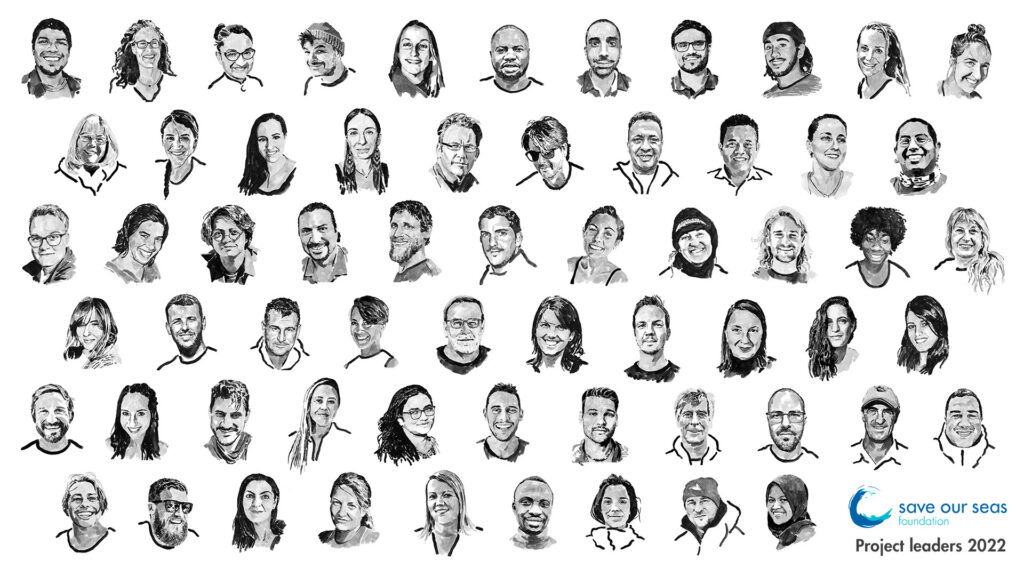
At the heart of our foundation lies our Small Grants programme, and with 25 new awards this year (to recipients whose average age is only 32 years), the next era of bright conservation minds is being ushered in for an innovative future. Sustainability is central to Small Grant recipient Nazia Hossain’s research. Nazia is working in the Bay of Bengal to identify threats to hammerhead sharks from fishing and international trade and to evaluate the extinction risk of the species in the region. Using a sustainable fisheries approach, she will be investigating trade routes, fishing grounds and essential shark habitats, assessing fishers’ perceptions and gaining an understanding of fishing pressure in the Bay of Bengal.
Integrating local knowledge, improving the data collected by local fishers and including the community in environmental education – these are the hallmarks of Carolina de la Hoz’s project in Mauritania. As many as two-thirds of the sharks and rays in Banc d’Arguin, a shallow bay in Mauritania’s National Parc du Banc d’Arguin, are threatened with extinction. Carolina is assessing the diversity of the sharks and rays in the bay with a view to improving local understanding of their importance and their plight.
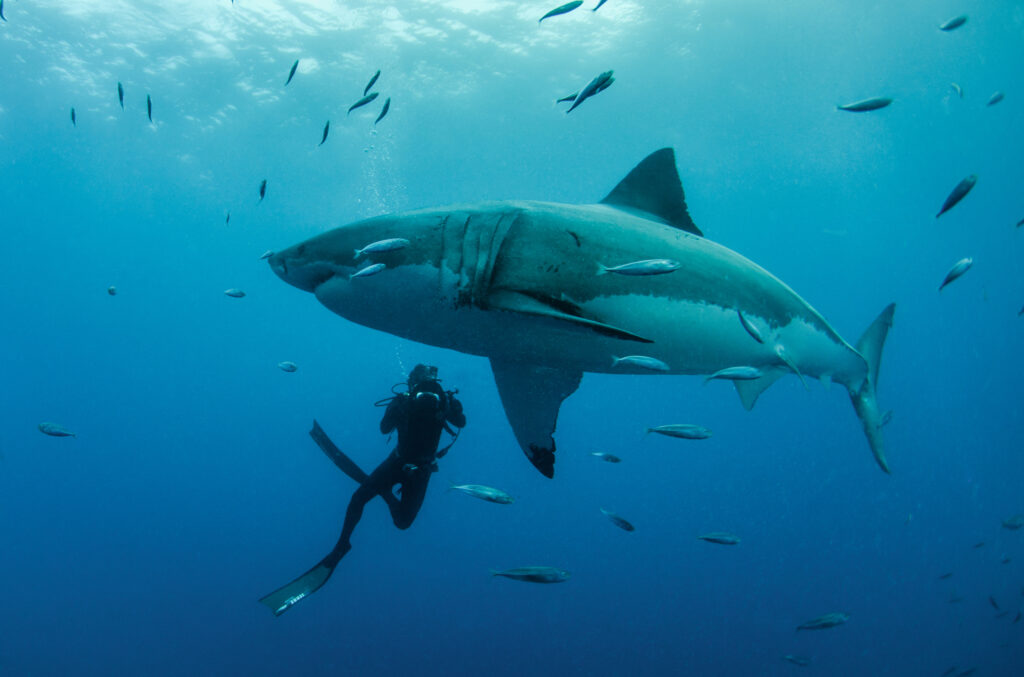
Photo © Byron Dilkes
New knowledge is what Anna Simeon is aiming for as she collects genetic information from white shark fin clips to assess this shark’s population size in South Africa. She also aims to develop a monitoring protocol that can make use of genetic samples collected during shark net and drumline patrols by KwaZulu-Natal’s Sharks Board. This information is particularly pertinent in South Africa, where the conservation of a protected species has to be balanced against concerns about bather safety.
Bringing the public on board is where Segun Oladipo’s work stands out. Segun is gathering the first data for one of only two freshwater stingrays in Africa, the pincushion ray. By establishing and training the first Nigerian Stingray Conservation Team to collect citizen science fishery data, surveying the distribution of and threats to this stingray, and driving awareness campaigns with communities, Segun’s project will bring new understanding of a little-known species.
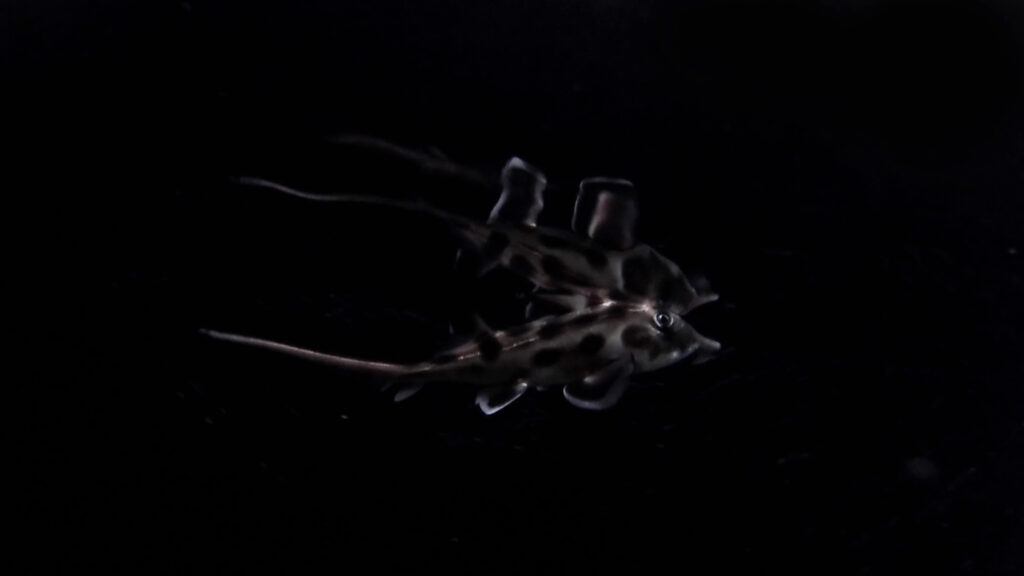
Photo © Francisco Concha
– SOSF chief executive officer, Dr James Lea.
Five new projects have been funded as part of our Keystone Grants programme. Among these, Sandra Bessudo is characterising the shark communities in Colombia’s Malpelo Fauna and Flora Sanctuary, while filmmaker Craig Foster and scientist Dr Jannes Landschoff are diving into the Great African Seaforest in South Africa to bring ashore 1001 stories of its species. These projects bring large-scale vision to local challenges, offering global solutions to conservation.
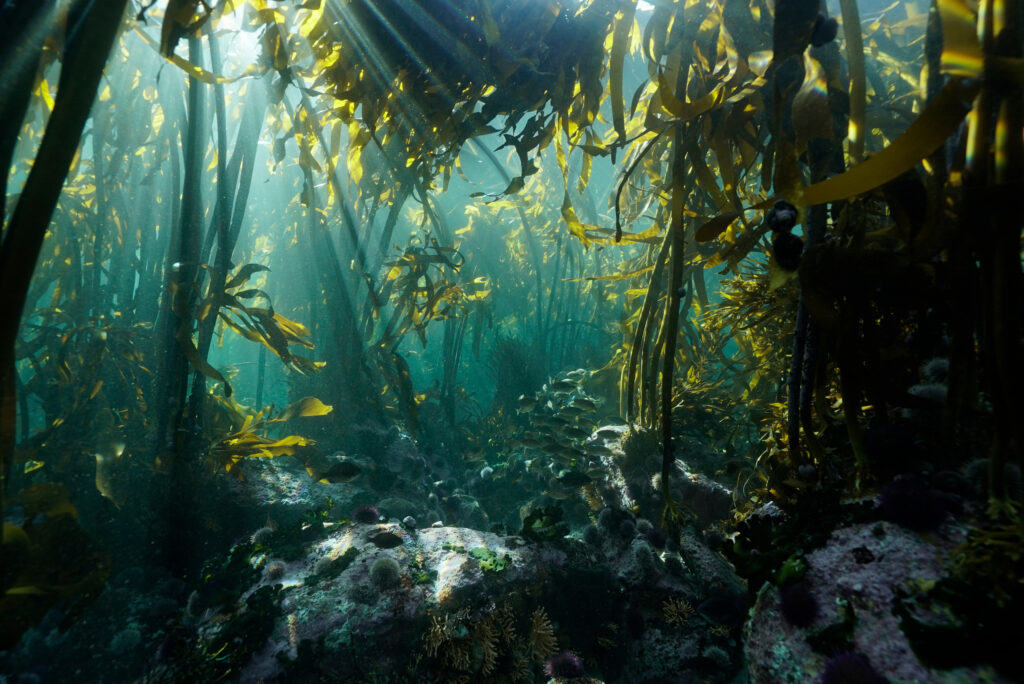
Photo © Craig Foster | Sea Change Project
Conservation relies on continuity, and sound scientific results are the product of many years of ongoing work. With this in mind, we have issued 25 continuation grants for existing keystone projects. We also continue to fund our SOSF D’Arros Research Centre in Seychelles, the SOSF Shark Education Centre in South Africa and the SOSF Shark Research Center in the USA. Our foundation also renewed funding for its longstanding partners – the Bimini Biological Field Station Foundation, Manta Trust, North Coast Cetacean Society, Shark Spotters and the Acoustic Tracking Array Platform – in full recognition of the value that collaboration and partnership can bring to conservation solutions.
The SOSF has funded 425 projects since its inception in 2003. This year alone, 60 projects across the world are receiving support.
See below for the full list of our new project leaders for 2022
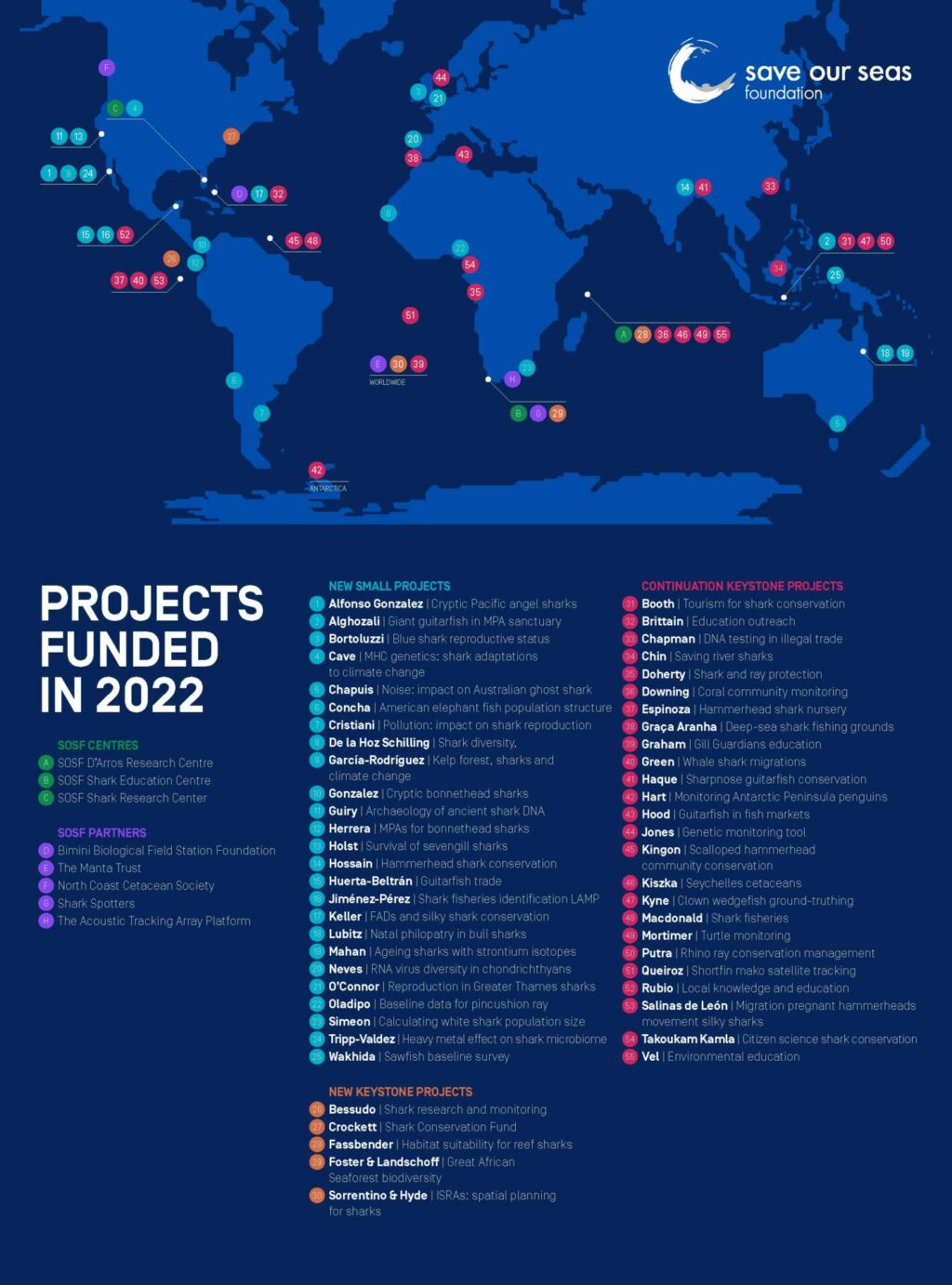
Artwork by James Thom | © Save Our Seas Foundation
SMALL GRANTS:
Massiel Alfonso Gonzálezis something of a squatinid sleuth, aiming to decipher whether the north-eastern Pacific’s only angel shark species, the Pacific angel shark, has a cryptic, endemic (found nowhere else in the world) counterpart in the Gulf of California.
Faqih Alghozali is filling the gaps in the scant knowledge about giant guitarfish in Java’s Karimunjawa National Park marine protected area. Karimunjawa is located near Northern Java’s main fishing grounds, but evidence of giant guitarfish caught in some of the use-zones of the protected area hints that the park may be a sanctuary for the species.
With a population that has declined by 70% in the Atlantic Ocean, the highly fished blue shark is Jenny Bortoluzzi’s key focus. Her project aims to understand whether the female blue sharks that spend their summers in Irish waters are reproductively mature and how their reproductive status changes during their time in the region.
Our changing global climate is bound to impact the ocean’s top predators, but how do we know what the outcome will be for sharks? Eloise Cave is keen to zoom in to understanding the genetic diversity of four understudied shark species to answer this question.
As evidence increases to show how noisy oceans are having an impact on marine mammals, studies are expanding to explore how other species are coping – or not. Lucille Chapuis wants to understand how the Australian ghost shark – a deep sea species accustomed to low light that relies on its hearing to feed and navigate – is affected.
Francisco Concha is using molecular genetic markers to assess if the American elephant fish that is found in both the Atlantic and the Pacific oceans is one population or two. Basic information about this species is lacking, and its proper future management relies on filling these knowledge gaps.
Harmful pollutants in the ocean can disrupt the reproductive capacity of many species. That the future of sharks hangs in the chemical balance is a devastating thought – and it’s a scenario that Franco Cristiani is trying to understand so that we have a better chance of mitigating it.
Banc d’Arguin, a shallow bay in Mauritania’s National Parc du Banc d’Arguin, is home to many vulnerable shark species. Carolina de la Hoz Schilling is assessing shark and ray diversity in the bay, improving data collected by local fishers through identification training and raising awareness among the local community about the plight of elasmobranchs.
Emiliano Garćia-Rodriguez wants to assess the importance of kelp forest ecosystems to sharks and is using San Quintin Bay in Baja California to understand their value. He aims to show how changes in kelp forest communities might impact sharks in future climate scenarios.
Cindy Gonzales wants to know if bonnethead sharks in the eastern Pacific constitute a third cryptic species in the Sphyrna tiburo species complex. Panama is home to this complex, including S. t. vespertina on its eastern Pacific coast, but its cryptic populations on the country’s Pacific and Caribbean coasts need to be clarified.
Eric Guiry is casting back in time to understand how processes throughout history have shaped shark ecology today. Based in Monterey Bay, where declines in the 21 different local shark species have been attributed to overfishing and environmental change, he is using archaeological sites to understand thousands of years of shark history.
Maria Herrera wants to help identify good areas to establish no-take zones for marine protected areas to protect hammerhead species. Her project focuses on scoophead and scalloped bonnethead sharks and scalloped hammerhead sharks, which co-occur on Colombia’s Pacific coast.
Megan Holst wants to know all about sevengills in San Francisco Bay: what they’re eating at different ages and life stages, where they’re spending their time and whether they are stressed by handling in the recreational catch-and-release fishery.
Nazia Hossain is set on establishing a solid scientific basis for the adequate conservation of Bangladesh’s hammerhead sharks. To do so, her project is adopting a sustainable fisheries approach to achieve several aims.
Bryan Beltran is on a mission to know which guitarfish species are caught, cut and modified to have a ‘devil-like’ appearance before being sold in Mexico’s curio and medicinal markets as pez diablo.
Fish aggregating devices (or FADs) are used by tuna fishers globally to attract shoals of their target species. Unfortunately, highly threatened and social silky sharks also form large aggregations – and often near these floating attractions in the ocean. Bryan Keller wants to know what’s driving these aggregations to form near FADs.
Nicolas Lubitz is concerned about Australia’s bull shark nurseries: the coastal bays and rivers where these sharks go to pup. Evidence has shown that female bull sharks may return to the same nurseries where they were born to give birth to their own pups and that they repeat this pattern each reproductive cycle.
Brandon Mahan is applying novel and state-of-the-art techniques to assess the age of sharks and determine their migratory patterns. Knowing how sharks age is critical to properly managing their populations in fisheries, ensuring that the harvesting of them is sustainable and that they can recover.
Populations of sharks and their cousins – the rays, skates and chimaeras we call chondrichthyans – have suffered declines as a result of overfishing, habitat degradation and pollution, and will continue to do so as our climate changes. But what about sharks that get sick? Fabiana Neves is investigating the most prevalent kind of viral infection in chondrichthyans – RNA viruses.
Luke O’Connor‘s stance is that the more we understand about sharks and how they use their environment, the better we can protect the critical marine habitats that they need to survive. The Greater Thames Estuary in south-eastern England is one such important environment for sharks such as the Critically Endangered tope shark and the north-eastern Atlantic population of spurdog shark (also known as spiny dogfish).
Segun Oladipo is gathering the first data for the pincushion ray, one of only two freshwater stingrays in Africa. By establishing and training the first Nigerian Stingray Conservation Team (NSCT) to collect citizen science fishery data, surveying the distribution and threats of this stingray, and driving awareness campaigns with communities, Segun’s project will bring new understanding for a little-known species.
Alexis Jiménez-Pérez is keen to close the knowledge gap and assess the best means of identifying shark products sold as fillets in Mexico. Focusing on the country’s most fished species, he hopes to test a method that is based on DNA and proteins and is called loop-mediated isothermal amplification (LAMP).
Anna Simeon is collecting genetic information from white shark fin clips to assess this species’ population size in South Africa. Using close-kin mark-recapture analysis instead of traditional methods, she hopes to provide an accurate account of South Africa’s white shark population size.
A healthy microbiome is key to fitness in sharks and rays, but increasing amounts of heavy metals in the ocean could disrupt these microbes and impact shark and ray immune systems. Miguel Tripp wants to understand shark microbiomes because impaired immunity will make already threatened sharks and rays more susceptible to environmental stress.
Yunita Wakhida is in search of sawfish in Asmat Regency, in the Papuan provinces of Indonesia. Her project will describe the current presence, distribution and diversity of sawfish species in the region. She will also be investigating the cultural and socio-economic value of sawfish for the people of Asmat Regency.
KEYSTONE GRANTS
Sandra Bessudo is using multiple methods to characterise the shark communities in Colombia’s Malpelo Fauna and Flora Sanctuary. Using a combination of baited remote underwater video systems (BRUVs), underwater visual census (UVC) done on scuba dives, remotely operated vehicle (ROV) dives and tracking information downloaded from acoustic telemetry receivers, she hopes to improve the kind of information available about sharks and rays in this marine protected area in the Colombian Pacific Ocean.
Lee Crockett is the Executive Director of the Shark Conservation Fund (SCF), who distribute grants, aiming to end the global overexploitation of sharks and rays. Using sharks and rays as flagship species, the fund’s mission is to protect the health of the oceans by maintaining their function.
Nico Fassbender is using acoustic telemetry and BRUVs around Seychelles to explore how reef sharks are using their reef homes. What are they eating? What prey is available? His project aims to explore what factors influence ideal habitats for sharks and will combine information from both pristine and degraded reefs to create a model to test this suitability.
Craig Foster and Jannes Landschoff are diving into the Great African Seaforest in South Africa to bring to shore 1001 stories of the species that live there. Combining marine biological research with the art of underwater tracking, nature documentary-making and storytelling, the pair from the Sea Change Project hope to build a biodiversity dataset from the region that will grow and ultimately nurture a new appreciation for the fragility and wonder of nature.
Ciaran Hyde, Lynn Sorrentino and Rima Jabado are refining criteria to identify and delineate important regions of the world’s oceans that are critical habitats for sharks and rays. Its mission is to help guide spatial planning, ensuring that essential shark and ray habitats are protected and that their importance is highlighted to policymakers.
